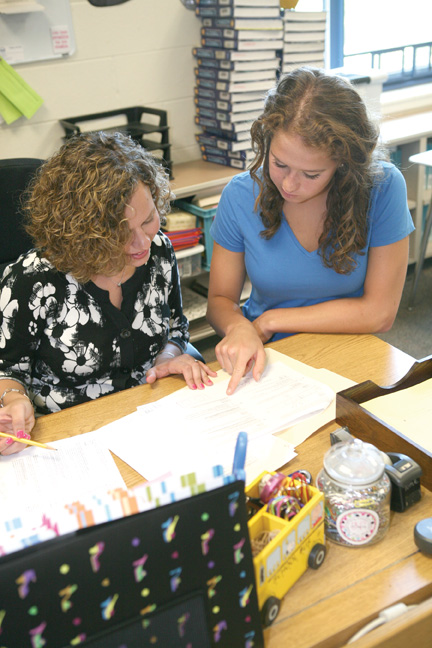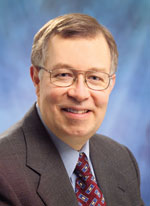More Than 1 Million and Counting: The Growth of Advanced Placement Statistics

Nine of the leaders at the 2012 AP Statistics reading in Kansas City, Missouri. From left: Al Reiff, Laura Schultz, Peter Valerio, Libby Lerner, Allan Rossman, Roxy Peck, Jim Freeman, Tim Bator, and Ann Cannon
Last month, I noted that the number of high-school students taking Advanced Placement (AP) Statistics has grown dramatically, contributing to an increase in the number of undergraduate statistics majors. This column takes you to the reading for the AP Statistics exam, introduces you to some extraordinary educators, and explains how you can contribute in the classroom.
What Is So Exciting About Grading Exams?
That was my question when I first heard that 610 high-school teachers, college faculty, and other statisticians were traveling to Kansas City, Missouri, on June 9 to read AP Statistics exams for an entire week.
The answer—as I learned by visiting the reading—is that it provides such a rewarding professional development experience for teachers that they look forward to returning every summer. During the school year, these teachers are at the forefront of improving how statistics is taught at high schools across the country.
I thank Allan Rossman (Cal Poly, San Luis Obispo), chief reader for the exam, for inviting me to observe the reading. Two experienced readers, Jackie Dietz (Meredith College) and Tom Short (John Carroll University), served as my tour guides. I also am grateful to the many readers I met who shared their enthusiasm for teaching statistics.
Prior to my visit, Allan provided some facts about the exam. It covers a one-semester introductory college course in statistics. More than 1 million students have taken AP Statistics since it was first offered during the 1996–1997 school year. This spring, 152,750 students took the exam—a 7% increase over last year’s number and 20 times the number that took the first exam in 1997. The 2012 exam consisted of 40 multiple-choice questions and six free-response questions.

Randall Miller (Plant City High School in Florida) has attended 15 out of the last 16 readings of the AP Statistics exam.
Awaiting the readers was a Herculean task: scoring 916,500 free-response questions in one week. This requires such a high degree of coordination that the reading process is a story in itself.
Beginning with the Acorns
When I arrived in Kansas City on June 9, Jackie took me to the convention center, where the reading was to commence the next day. We sat in on a meeting for new readers—who are appreciatively known as acorns—and learned about the process.
Everyone has a reading partner, and eight people work together at a table. Acorns are paired with experienced readers, and they read the first 25 exams together. Scoring speed does not matter. Instead, the prime directive is “to score exams as consistently as possible according to the rubric.”
Punctuality is also essential. If everyone were to show up five minutes late at each stage, the setback would amount to losing 26 readers.
Acorns were told to expect a full range of professional development activities after 5 p.m. This year, the activities included a presentation by Sharon Bertsch McGrayne, author of The Theory That Would Not Die.
Becoming One with the Rubric
At general orientation the next morning, Allan told us more about the rubric. This is a set of scoring guidelines, with one set for each of the free-response questions. Rubrics are prepared by leaders who arrive four days in advance.
I wondered how the rubrics could be applied consistently by so many readers. Following orientation, the readers split into training groups for two of the questions. Leaders reviewed the scoring for each part of the question. Then, readers practiced by scoring sample responses, submitting their scores with clickers, and comparing the results to build consistency.
Readers were subsequently organized into 68 tables, each with a leader. Tom noted that these readers score the version of the exam that is taken by the majority of students. A smaller team scores alternate and overseas versions.
Teaching Statistics More Effectively
Throughout my visit, I met readers who described why the reading is such a valuable experience for statistics educators and how their students benefit from learning statistics.
Ann Cannon (Cornell College) pointed out that readers come from a variety of institutions, including public schools, private schools, colleges, and universities. All readers are deeply interested in learning how to teach statistics more effectively.
This learning happens in three ways, explained Daren Starnes (The Lawrenceville School). “First, by reflecting on statistical concepts while applying the scoring guidelines. Second, by networking with other enthusiastic professionals during the week. And third, by experiencing how a well-designed assessment promotes statistical thinking and clear communication.”
Al Reiff (Taft School) added that teachers bond at the reading because the grading process requires collaboration to understand what students are trying to communicate.
Nathan Kidwell, an acorn from Holly, Michigan, told me what he gained: “The confidence and knowledge that I take back to my classroom will be invaluable. I can’t wait to get back to school in the fall to relate my experiences and delve deeper into statistics.”
Engaging Students with Statistics
John Mahoney, who teaches in an inner-city school in Washington, DC, has found that statistics courses engage and empower many high-school students. He said, “Students can walk into class any day and quickly see why someone would be interested in the problems that are being discussed. The problems have a practical, real-life setting.”
Teachers are encouraged by former students who discover that statistics is highly relevant to their work. One former pupil said to Al, “Make sure you tell everyone they need to take statistics. On the job, it’s the most important math skill you need to have.”
Improving Statistical Literacy of Scientists
Doug Everett (National Jewish Health) is a physiologist who has been a reader since 2009. Doug attends the readings because he wants to improve statistical literacy among researchers in science. This is a long-term effort that he compares to “changing the course of an ocean liner with a kayak.”
Doug believes AP Statistics will make the difference by preparing tens of thousands of future researchers with an early understanding of statistical thinking. Many of these students are motivated to take additional statistics courses at the university level.
Doug adds, “The ultimate impact on statistical literacy in science is likely to originate from AP Statistics—from its passionate, committed teachers and from its students who end up as researchers in science and medicine.”
Launching Statistical Careers
After returning from the reading, I met a local AP Statistics teacher, Nancy Lassiter (Green Hope High School), whose former students are using statistics in a variety of careers. Among the students Nancy has taught during the past nine years, three are now applying statistics to research in traffic safety, material science, and health studies. One is working on a master’s degree in biostatistics, and two are planning to major in statistics this fall. Another former student will be teaching AP Statistics next year.
Improving Statistics Teaching with JSM Workshops
The 2012 Joint Statistical Meetings (JSM) in San Diego, California, provided additional development opportunities for AP Statistics teachers. The ASA/NCTM Joint Committee on Curriculum in Statistics and Probability again sponsored a Beyond AP Statistics (BAPS) workshop, organized by Roxy Peck (Cal Poly, San Luis Obispo).
BAPS workshops offer enrichment material that is one step beyond the AP syllabus. This year, the topics were randomization tests, logistic regression, what to do when assumptions are not met, and engaging students in statistics.
Sharon Hessney (John D. O’Bryant School of Math and Science), who attended the BAPS workshop at JSM 2011, wrote, “The sessions were particularly effective because the presenters related their topics to our curriculum.”

Nancy Lassiter (left) reviews sample exam questions with Hannah Bultman, one of her AP Statistics students. Photo by Ken Weigand
JSM 2012 also provided statistics workshops for math and science teachers at the middle- and high-school levels. Sponsored by the ASA and chaired by Katherine Halvorsen (Smith College), this program—known as Meeting Within a Meeting—enhances the teaching of statistics within the mathematics/science curriculum through conceptual understanding and real-world data applications.
Helping Your Local Statistics Teacher
The teachers I met as I prepared this column are leading the way in improving how statistics is taught in American schools. Unfortunately, in most middle schools and high schools, statistics is taught by teachers who are not well prepared in this area. Many lack familiarity with statistics as a critical reasoning skill and with real-world applications of statistics.
Here is how you can make a difference: Contact your local school and meet the statistics teacher. Volunteer to visit the classroom and talk about your work. Offer to help with a statistics lesson. K-12 resources are also available.
September is the perfect month for us to connect with classrooms. This month is also the beginning of a school year that extends into 2013, the International Year of Statistics (IYOS).
Is there a better way to celebrate IYOS than helping teachers with our experience, expertise, and encouragement? Better teaching will lead to greater statistical literacy, increased public awareness of the contributions of statisticians, and a work force that is adequately equipped with statistical skills.
Lee Kucera (Capistrano Valley High School) urges all of us to help teachers by bringing the world of statistics into their classrooms. “The results,” she promises, “will be phenomenal!”
Read about the experiences of AP Statistics teacher Stephen Miller.


















Wonderful article. Captures the essence quite well of the reading experience. I have participated in the reading of the AP Statistics exam for the past six years. It has been a valuable experience. I believe that I am a better teacher because of it. I look forward to many more years of serving the College Board in this capacity.